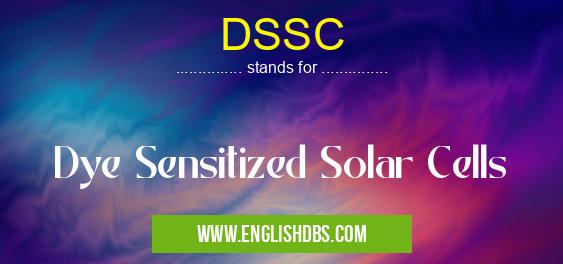What does DSSC mean in UNCLASSIFIED
Dye Sensitized Solar Cells (DSSCs) use a photosensitive dye, often a ruthenium compound, to capture light and generate an electrical current. The dye is sandwiched between an electrolyte and a transparent conducting layer of titanium dioxide nanoparticles, which acts as the semiconductor. When light is absorbed by the dye, electrons are released and captured by the semiconductor instead of the electrolyte. These electrons then flow through a circuit and are ultimately converted into electricity.

DSSC meaning in Unclassified in Miscellaneous
DSSC mostly used in an acronym Unclassified in Category Miscellaneous that means Dye Sensitized Solar Cells
Shorthand: DSSC,
Full Form: Dye Sensitized Solar Cells
For more information of "Dye Sensitized Solar Cells", see the section below.
Essential Questions and Answers on Dye Sensitized Solar Cells in "MISCELLANEOUS»UNFILED"
How do Dye Sensitized Solar Cells work?
What are some advantages of Dye Sensitized Solar Cells?
Dye Sensitized Solar Cells (DSSCs) offer several advantages compared to traditional solar cells, such as increased efficiency in low-light conditions, reduced cost in both production and installation, and improved flexibility for applications requiring thin or curved surfaces. Additionally, they can be produced with materials that are non-toxic and environmentally friendly.
What type of environment are DSSC's best suited for?
Dye Sensitized Solar Cells (DSSCs) are best suited for environments where direct sunlight may not be readily available due to weather patterns or physical obstructions. They work well under cloudy conditions or diffused lighting because their photosensitive dyes are capable of capturing more light than traditional silicon-based solar cells.
Are all DSSC installations permanent?
No, not all Dye Sensitized Solar Cell (DSSC) installations need to be permanent – they can also be designed as mobile units that can be folded up easily when not in use or moved from one location to another. This makes them useful for applications that require flexibility while still providing efficient energy conversion from natural light sources.
How much energy does a single cell convert?
The amount of energy generated by a single cell varies depending on its size and cell configuration; however, it typically ranges between 20mW/cm² and 80mW/cm² in direct sunlight. Generally speaking, larger cells tend to generate more energy but require more space for proper installation and cooling systems if necessary.
Are there any other practical applications for DSSC technology?
Yes! In addition to generating electricity from natural sunlight sources, Dye Sensitized Solar Cell (DSSC) technology has been used in other projects such as water purification systems and self-powered wearable electronics devices.
Is there any special maintenance required for DSSCs?
As with any other type of solar panel system, regular maintenance is recommended to ensure optimal performance over time – this includes cleaning dirt or debris off the surface of the cells as needed and checking connections regularly for any signs of corrosion or wear & tear. Additionally, regular monitoring should be done along with calibration adjustments if necessary in order to keep output levels consistent year-round.
Are there different types of dyes used in DSCCs?
Yes; there are several different types of dyes that can be used in DSCCs depending on the application requirements – some examples include ruthenium compounds (commonly used in indoor applications due to their high sensitivity), copper phthalocyanines (more suitable for outdoor conditions due to their improved resistance against environmental factors), squaraines (particularly useful for third generation technologies), etc.
Do DSCCs produce harmful emissions?
No – DSCCs have been found both safe and eco-friendly since they produce no harmful emissions during operation since they rely exclusively on natural light sources instead of fossil fuels like many traditional power generation methods do.
Are DSCCs vulnerable to extreme temperatures?
While some degradation can occur if exposed to extreme temperatures over extended periods of time, DSCCs generally remain functional even at high temperatures as long as proper cooling mechanisms are put into place along with meaningful insulation layers around the cells themselves if necessary.
